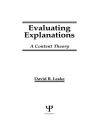First published in 1977, this now classic manual has been completely revised and updated to reflect the enormous changes that have taken place both in the popularity of repertory grid methods and in the study of the methods themselves.
Aimed at novices as well as those already knowledgeable about grid usage, this manual provides an overview of George Kelly’s personal construct theory, which underpins repertory grid methods. The reader will learn how to design a grid, with guidance on how to choose elements and ways of eliciting personal constructs that can influence the results obtained.
The second edition includes multiple examples of grids, as well as:
New chapters on the main computer methods of analysis available
Supporting website with grid analysis programs available to download
Extended annotated bibliography of the many examples of grid usage
This book will appeal to psychology students, practitioners and academics. Other professionals who will find this an invaluable guide include managers, teachers and educationalists, speech and language therapists, nurses, probation officers and psychiatrists.
สารบัญ
About the Authors ix
Preface xi
Acknowledgements xiii
1. The Basis of Repertory Grid Technique 1
Grids: What Are They? 1
The Grid as Part of Personal Construct Theory 5
Grids: a Measure of What? 5
Grids are about Constructs 7
Some Personal Construct Theory Corollaries 9
Different Kinds of Construct 12
Constructs in Transition 12
Conclusions 12
2. Constructs And Elements 15
What is an Element? 15
What is a Construct? 15
Elements in a Grid 18
The Nature and Types of Constructs in a Grid 23
Ways of Eliciting Personal Constructs from ’Elements’ 27
Eliciting Personal Constructs in Ways other than from ’Elements’ 30
Eliciting Constructs from Constructs 39
To Elicit or to Supply Constructs? 46
Classification of Constructs 49
Which are more Important in a Grid – Elements or Constructs? 50
Constructs and Elements: the Debate 50
Comment 52
3. Varieties Of Grid In Use Today 54
The Grid Form of the Role Construct Repertory Test 54
The Split-Half Method of Allocating Elements 56
A Grid Using Rankings 56
A Grid Using Ratings 59
Implications and Resistance-to-Change Grids 65
Resistance-to-Change Grid 70
A Bipolar Implications Grid 73
Dependency Grid 76
A Textual Grid 78
A Qualitative Grid 79
Comment 80
4. Analyzing Grid Data 82
Repertory Grids 82
Analyzing Constructs 83
Analyzing Elements 91
Joint Representations of Constructs and Elements 93
Representations of Multiple Repertory Grid Data 98
Dependency Grids 101
Implications Grids 104
Comments 108
5. Some Summary Measures Of Structure 113
Cognitive Complexity 114
Extremity and Ordination 121
Conflict 122
Element Indices 124
Measures of Superordinacy 126
Measures of Intransitivity 127
Implications Grids 128
Dependency Grids 129
Comment 130
6. Reliability and Validity 132
Reliability 132
Conclusions 143
Validity 143
Conclusions 151
7. Specific Ways Of Using Grids 153
The Individual and the Grid 154
A Decision-Making Grid 162
Wholly or Partially Standardized Grid Formats 163
Conclusions 167
8. Some Uses To Which Grids Have Been Put 168
Grids in General 169
In the Clinical Setting 170
Working with Children 188
Teachers and Teaching 192
The Construing of Professionals 195
Those With Learning Difficulties 196
Social Relationships 199
Language 204
Dependency 210
The Use and Abuse of Drugs 211
The Family 212
Forensic Work 213
Maps, Planning and Environment 215
Market Research 217
Politics 218
Careers 219
Sport 220
Organizational and Business Applications 220
More Unusual Uses of Grids 226
Appendix Computer Programs and Websites 230
References 232
Author Index 258
Subject Index 262
เกี่ยวกับผู้แต่ง
Fay Fransella is Founder and Director of the Center for Personal Construct Psychology, Emeritus Reader in Clinical Psychology, University of London and Visiting Professor of Personal Construct Psychology at the University of Hertfordshire. She has written 11 books, eight of them specifically relating to personal construct psychology and the use of repertory grids, and she has published over 150 journal papers and book chapters. She wrote the first edition of A Manual for Repertory Grid Technique with Don Bannister for Academic Press in 1977.
She trained and worked as an occupational therapist for 10 years before taking a degree in psychology and a postgraduate diploma in clinical psychology in 1962. It was during her first job as a lecturer at the Institute of Psychiatry, London, that she was introduced to George Kelly’s personal construct psychology and his repertory grid method. Both were revolutionary alternatives to the dominant behaviorism of the time. She found the view that we are all free agents responsible for what we make of the events which continually confront us particularly liberating. Since that time she has conducted research, together with teaching and writing, within the framework of Kelly’s ideas. Her main area of research has been stuttering, for which she used a form of repertory grid. She has also conducted research on weight disorders and various psychological problems.
Richard Bell is an Associate Professor of Psychology at the University of Melbourne. He is interested practical problems of measurement in clinical, organizational and educational settings. He has written extensively on the analysis of repertory grid data and has authored widely used software for the analysis of such data.
The influence of Don Bannister in arousing interest in George Kelly’s theory and methods of assessment has been profound. Even after his untimely death in 1986 his influence continues, through those he inspired, through his professional research and writings, and also through his four novels. In the year in which this second edition of the Manual for Repertory Grid Techniques is published the 15th International Congress in Personal Construct Psychology was held in Huddersfield, UK, focusing on that outstanding influence. He spent much of his professional life carrying out research for the UK Medical Research Council, which included a year working with George Kelly at Ohio State University in 1965. He saw the psychology of personal constructs as an approach to the person that was empowering, democratic and, above all, valuable in helping people understand themselves and others. He was insistent that psychologists should use what power and influence they have to make a difference in the lives of people. He would have taken great interest in the vast amount of new work that has been carried out with and into that tool which is detailed in this second edition of the book that he co-authored in 1977.












